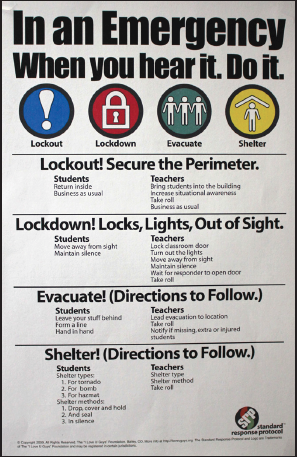When students come to school they expect to be and feel safe. Parents don’t want to have to worry about their kids being in danger. This year Lincoln High has new emergency procedures. Instead of the past Code Red that everyone came to know, we now have what is called a Lockdown or a Lockout. These new procedures were created by the LPS Director of Security Joe Wright, who has been researching different emergency protocol systems for a couple years, according to Associate Principal Mark Larson Wright believes that this system is going to be adopted by all of the schools, and also the city uses a lot of the same language we use. These new procedures are confusing for the students who are used to Code Reds, but they are simple enough to learn fast and are easily remembered.
“I think they are a step in the right direction. [They’re] much clearer language for students and staff to understand what to do in specific emergency situations.” added Larson. The new procedures are as simple as changing the way we say it. Lockdown and Lockout. When the threat is inside the building this is called a Lockdown. This is when the staff and students need to shut the lights off, lock the doors and hunker down until we can figure out what is going on and get it resolved. A Lockout on the other hand is when the threat is outside the building.
This is what we had a month ago when there was a suspect on the loose from a domestic dispute in the LHS neighborhood. Until the Lincoln Police Department had the suspect in custody, the school had to go into a “Lockout”, which means that we have to lock all of the doors and make sure that the only people we are letting in are Lincoln High staff and students. In the meantime everything inside the building goes on as normal. Larson said, “It’s great we have those one word communication tools, so that everybody knows exactly kind of what to do and what’s going on.”
When you are in an emergency situation things can be stressful and when there are a lot of things going on it can be easier on a person if they don’t have to think about what to do. This is what Larson thinks will make the school a safer place for everyone. “And so when you hear that one word-either Lockout or Lockdown-you know exactly what to do,” Larson said. Larson would also like to communicate with the students about being safe in these situations and that we want them to have the opportunity to protect themselves. For instance if the school is in a Lockdown situation the students know that they can be safe by going into the classrooms and locking the doors and turning the light off until it is safe.
But there is one way that is not communicated well: If a student does not feel safe where they are in the school no matter where, they have the option to leave and go home. The student would then need to call either the school or the district office and tell them where they are and why they didn’t feel safe. “You know we feel like we have a natural instinct to fight or flight, and those are good natural things that we want kids to be able to use. So if you don’t feel safe, talk to an adult or get out of the situation. Those are two things we want students to practice and get better at,” Larson said.
